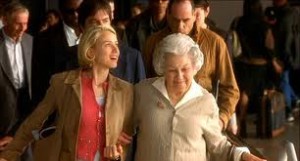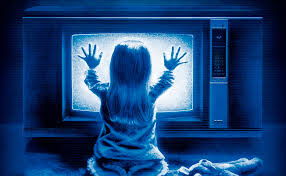Posted by Sarah
Our post-film discussion covered several areas, including how melodrama functions in Mulholland Drive; the relationship between the melodrama and horror genres; David Lynch’s other films; and definitions of melodrama. Do log in to comment, or email me on sp458@kent.ac.uk to add your thoughts.
 We began the discussion by noting the ways in which Mulholland Drive (2001) was related to our understanding of melodrama. Broadly speaking, the fact the plot focused on love and domestic matters was thought to relate closely to the family focus present in many melodramas. At a more specific level, some of the aesthetics pointed to melodrama: especially the scene which places Betty (Naomi Watts) firmly within the domestic setting of the kitchen as she makes coffee at the huge sink. This had echoes of 1950s melodramas, especially as it externalised the internal states of characters. Other of the film’s settings, and the costumes, also harked back to earlier Hollywood.
We began the discussion by noting the ways in which Mulholland Drive (2001) was related to our understanding of melodrama. Broadly speaking, the fact the plot focused on love and domestic matters was thought to relate closely to the family focus present in many melodramas. At a more specific level, some of the aesthetics pointed to melodrama: especially the scene which places Betty (Naomi Watts) firmly within the domestic setting of the kitchen as she makes coffee at the huge sink. This had echoes of 1950s melodramas, especially as it externalised the internal states of characters. Other of the film’s settings, and the costumes, also harked back to earlier Hollywood.
 Indeed the film was a self-conscious meditation on melodrama, especially Hollywood melodrama. At times this slipped into parody or pastiche. Betty’s boundless joy at arriving in Los Angeles in particular seemed like a moment from a bad 1950s melodrama, or perhaps a ‘Visit Hollywood’ advertisement. The staging, dialogue and acting in the first part of the narrative was self-consciously
Indeed the film was a self-conscious meditation on melodrama, especially Hollywood melodrama. At times this slipped into parody or pastiche. Betty’s boundless joy at arriving in Los Angeles in particular seemed like a moment from a bad 1950s melodrama, or perhaps a ‘Visit Hollywood’ advertisement. The staging, dialogue and acting in the first part of the narrative was self-consciously  unconvincing, especially when involving Betty. There was praise for Watts’ performance(s), however. The switch from perky optimistic Betty to distressed Diane was very well-realised. Watts persuasively inhabited the role of suffering Diane in the second part of the film, making the character markedly different through the way she held herself and facial expressions.
unconvincing, especially when involving Betty. There was praise for Watts’ performance(s), however. The switch from perky optimistic Betty to distressed Diane was very well-realised. Watts persuasively inhabited the role of suffering Diane in the second part of the film, making the character markedly different through the way she held herself and facial expressions.
Other self-conscious aspects of the film drew attention even more strongly to the fact the film was constructed prior to our viewing of it. At Club Silencio the emcee informs Betty and Rita that the sound has been previously recorded, foregrounding the importance of illusion. It was also suggested that it is significant that this is the point just before the film’s narrative turns: that it is signposts the switch from melodrama parody to melodrama ‘proper’ as Diane is seen to be really suffering. Other instances in the film appear to downplay the melodrama though. The dramatic, if not melodramatic, fight scenes are undercut by slapstick comedy and black humour. We have previously noted that melodramas use humour, sometimes of minor characters, in order to provide  some relief from the melodrama (for example in both film versions of Gaslight), thereby heightening the melodramatic aspects. It is perhaps unusual to find the dramatic and comedic so closely entwined as in Mulholland Drive, though interestingly Poltergeist, another film with links to horror, employed this tactic.
some relief from the melodrama (for example in both film versions of Gaslight), thereby heightening the melodramatic aspects. It is perhaps unusual to find the dramatic and comedic so closely entwined as in Mulholland Drive, though interestingly Poltergeist, another film with links to horror, employed this tactic.
The importance of horror, its similarities to and differences from melodrama, was also raised. Both genres externalise the internal and Lynch’s particular combination of the two genres in Mulholland Drive – attaching the horror aesthetic to the melodramatic plot – was especially unsettling. Comparisons to Lynch’s Lost Highway (1997) were made. It  was noted that Cowboy (Monty Montgomery) in Mulholland Drive served a similar function to Mystery Man (Robert Blake) in Lost Highway. The importance of performance in these and other Lynch films – such as Eraserhead (1977) and Blue Velvet (1986) – was also noted. Despite similarities, Lost Highway was thought to be out-and-out horror, while Mulholland Drive’s use of melodrama complicates the matter. It was suggested that Lynch’s film express a modern melodrama, related to the Gothic, which is extreme.
was noted that Cowboy (Monty Montgomery) in Mulholland Drive served a similar function to Mystery Man (Robert Blake) in Lost Highway. The importance of performance in these and other Lynch films – such as Eraserhead (1977) and Blue Velvet (1986) – was also noted. Despite similarities, Lost Highway was thought to be out-and-out horror, while Mulholland Drive’s use of melodrama complicates the matter. It was suggested that Lynch’s film express a modern melodrama, related to the Gothic, which is extreme.
This led, once more, to debate on the definition of melodrama. A definition of melodrama has proved somewhat elusive – Martin Shingler and John Mercer define it as a ‘sensibility’ (in Melodrama: Genre, Style, Sensibility, 2004). We wondered if it would be useful to more fully appreciate the fact melodrama, like other genres, is not static. While other genres allow for subgenres to become more fully integrated into notion of what that genre is, this seems less true of melodrama. This is especially odd given the fact that our screenings have revealed the versatility of melodrama and its omnipresence. Indeed Linda Williams (in ‘Melodrama Revised’. Refiguring American Film Genres: History and Theory (1998) pp. 42-88) states that melodrama is the American art form. Meanwhile Hollywood arguably remains the dominant force in world cinema.
If we begin to take into account more subgenres of melodrama, and looser relations that exist between melodrama and other genres, this would open up new areas of discovery. It was suggested that it might be more profitable to talk of the melodramatic rather than melodrama. In addition, while it would be positive to not speak of melodrama in pejorative terms, this is in fact the way in which people use it, and changing this seems unlikely to happen. This comments effectively on how the Melodrama Research Group has engaged with the notion of melodrama: as it is, rather than how it should be, understood. Over the last few weeks the collision of melodrama and horror (Poltergeist and Mulholland Drive) has been especially useful in showing the long reach of melodrama.
Many thanks to Frances for selecting such a fantastic and fascinating film, and for kick-starting such fruitful discussion…
